In-Depth Analysis: Trans-Saharan Gas Pipeline Project Report
VerifiedAdded on 2023/06/04
|20
|6854
|394
Report
AI Summary
This report provides a comprehensive reflection on the Trans-Saharan Gas Pipeline mega project, which aimed to construct a natural gas pipeline between Nigeria and Algeria to diversify EU gas supplies. The project, initiated with agreements between the involved governments and a feasibility study, faced significant challenges including insufficient funding, security issues, and decision-making delays. The report delves into these complexities, highlighting gaps in risk assessment, budgeting, and stakeholder management. It explores opportunities for applying project and program management principles to improve the project's viability, focusing on procurement, risk, cost, and human resource management. The analysis also covers the complex business, organizational, commercial, and legal environments, along with stakeholder priorities and supply chain dynamics. Strategic risk management, time and cost control, change management, and governance aspects are discussed, concluding with recommendations for future improvements. The report emphasizes the need for better risk assessment, stakeholder engagement, and adaptive management strategies to navigate the project's inherent complexities and ensure its long-term stability and success.
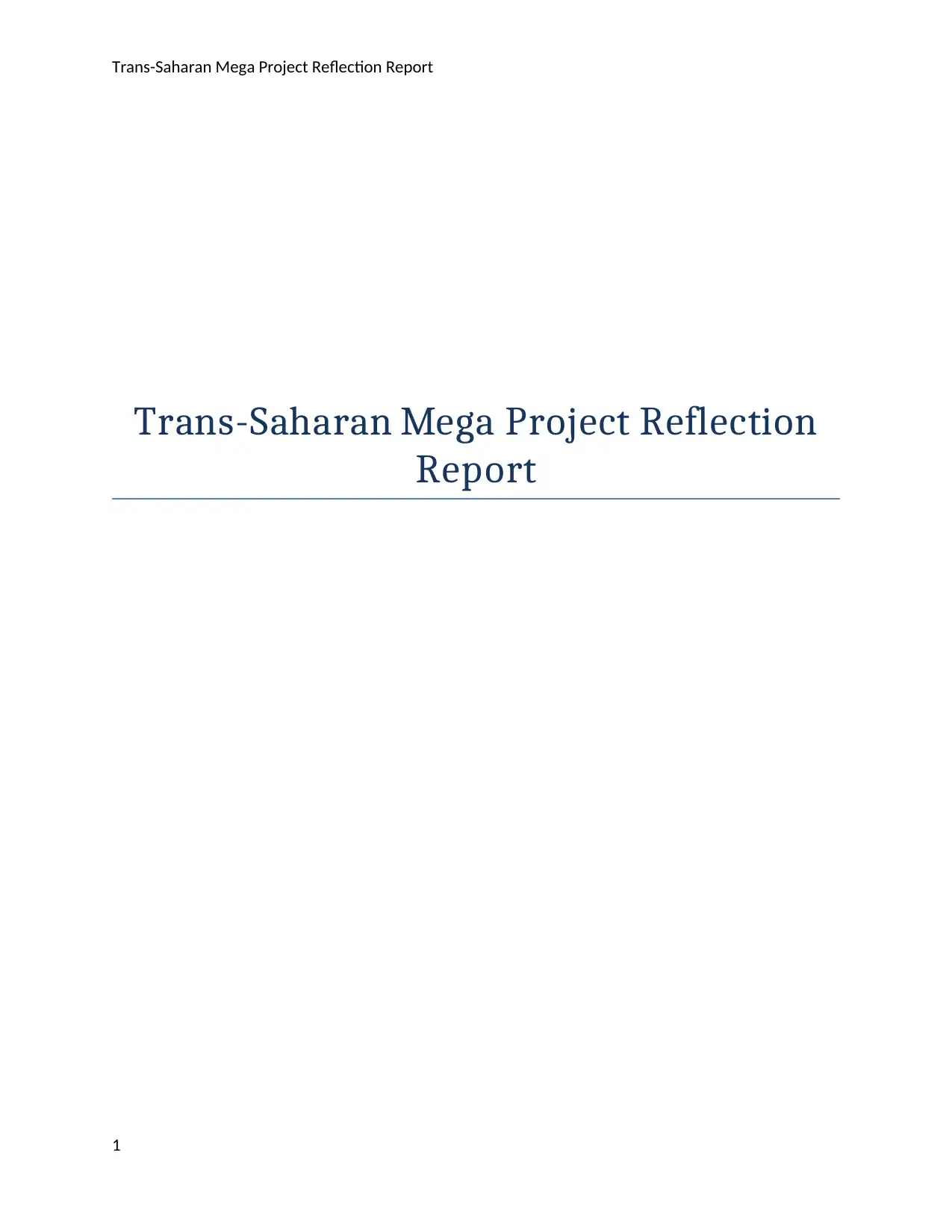
Trans-Saharan Mega Project Reflection Report
Trans-Saharan Mega Project Reflection
Report
1
Trans-Saharan Mega Project Reflection
Report
1
Paraphrase This Document
Need a fresh take? Get an instant paraphrase of this document with our AI Paraphraser
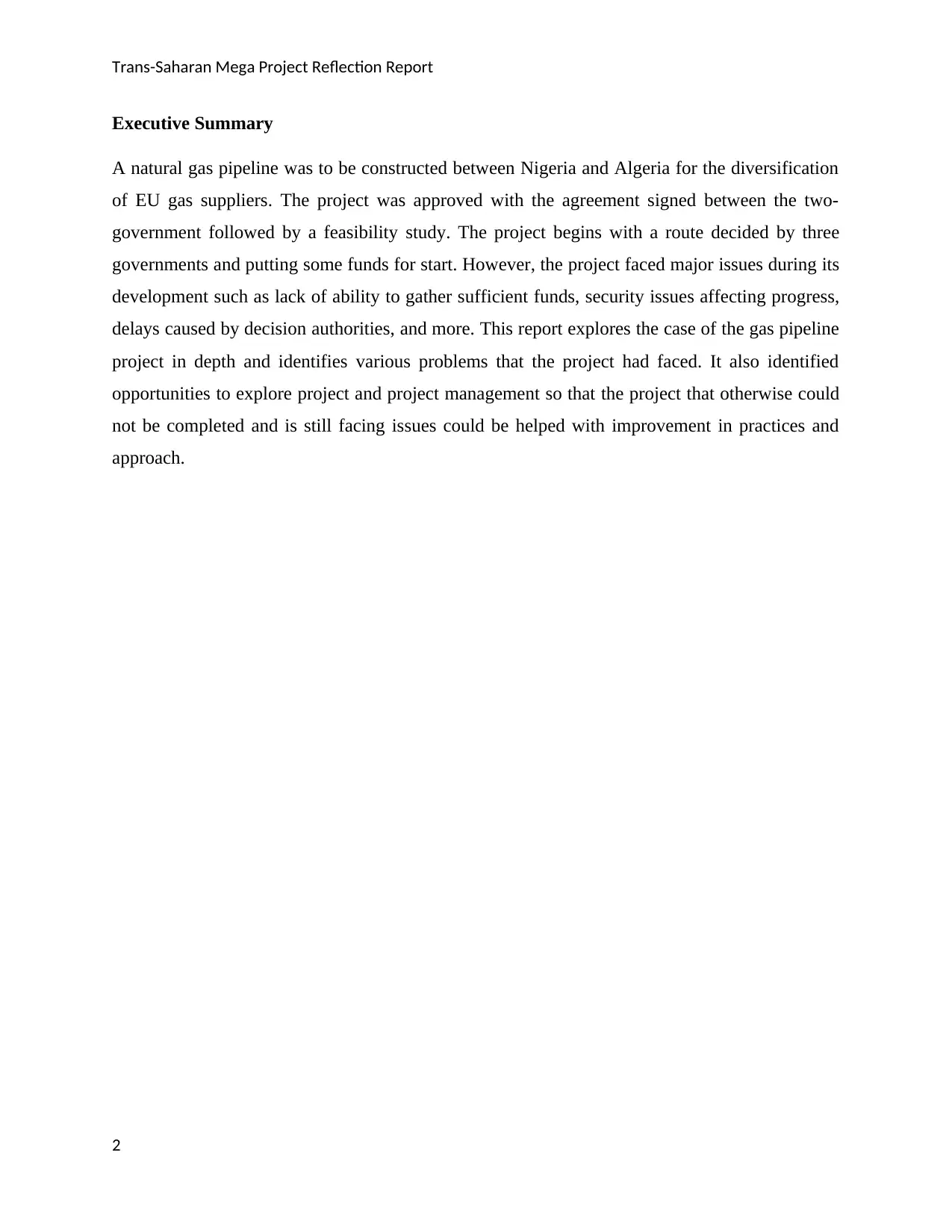
Trans-Saharan Mega Project Reflection Report
Executive Summary
A natural gas pipeline was to be constructed between Nigeria and Algeria for the diversification
of EU gas suppliers. The project was approved with the agreement signed between the two-
government followed by a feasibility study. The project begins with a route decided by three
governments and putting some funds for start. However, the project faced major issues during its
development such as lack of ability to gather sufficient funds, security issues affecting progress,
delays caused by decision authorities, and more. This report explores the case of the gas pipeline
project in depth and identifies various problems that the project had faced. It also identified
opportunities to explore project and project management so that the project that otherwise could
not be completed and is still facing issues could be helped with improvement in practices and
approach.
2
Executive Summary
A natural gas pipeline was to be constructed between Nigeria and Algeria for the diversification
of EU gas suppliers. The project was approved with the agreement signed between the two-
government followed by a feasibility study. The project begins with a route decided by three
governments and putting some funds for start. However, the project faced major issues during its
development such as lack of ability to gather sufficient funds, security issues affecting progress,
delays caused by decision authorities, and more. This report explores the case of the gas pipeline
project in depth and identifies various problems that the project had faced. It also identified
opportunities to explore project and project management so that the project that otherwise could
not be completed and is still facing issues could be helped with improvement in practices and
approach.
2
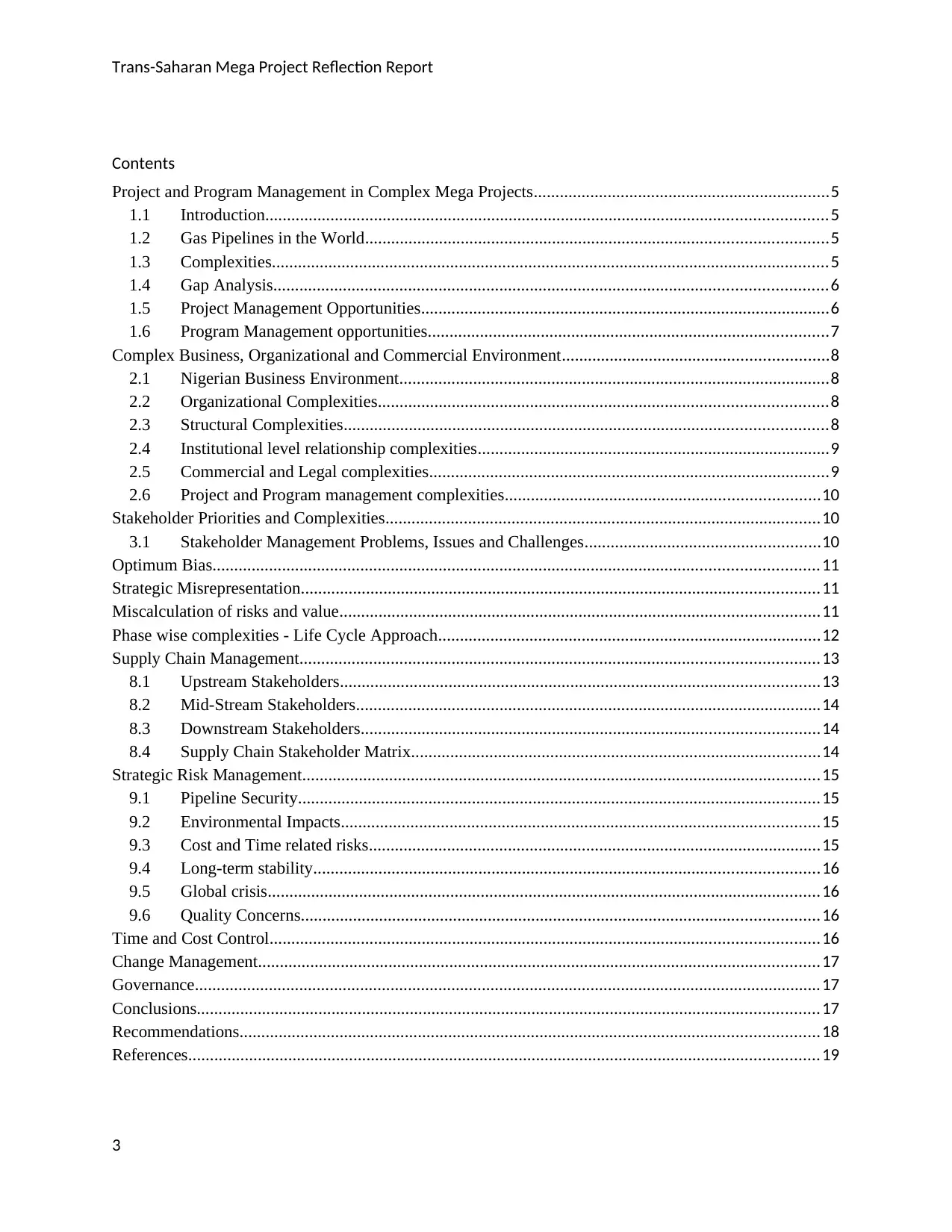
Trans-Saharan Mega Project Reflection Report
Contents
Project and Program Management in Complex Mega Projects....................................................................5
1.1 Introduction.................................................................................................................................5
1.2 Gas Pipelines in the World..........................................................................................................5
1.3 Complexities................................................................................................................................5
1.4 Gap Analysis...............................................................................................................................6
1.5 Project Management Opportunities..............................................................................................6
1.6 Program Management opportunities............................................................................................7
Complex Business, Organizational and Commercial Environment.............................................................8
2.1 Nigerian Business Environment...................................................................................................8
2.2 Organizational Complexities.......................................................................................................8
2.3 Structural Complexities...............................................................................................................8
2.4 Institutional level relationship complexities.................................................................................9
2.5 Commercial and Legal complexities............................................................................................9
2.6 Project and Program management complexities........................................................................10
Stakeholder Priorities and Complexities....................................................................................................10
3.1 Stakeholder Management Problems, Issues and Challenges......................................................10
Optimum Bias...........................................................................................................................................11
Strategic Misrepresentation.......................................................................................................................11
Miscalculation of risks and value..............................................................................................................11
Phase wise complexities - Life Cycle Approach........................................................................................12
Supply Chain Management.......................................................................................................................13
8.1 Upstream Stakeholders..............................................................................................................13
8.2 Mid-Stream Stakeholders...........................................................................................................14
8.3 Downstream Stakeholders.........................................................................................................14
8.4 Supply Chain Stakeholder Matrix..............................................................................................14
Strategic Risk Management.......................................................................................................................15
9.1 Pipeline Security........................................................................................................................15
9.2 Environmental Impacts..............................................................................................................15
9.3 Cost and Time related risks........................................................................................................15
9.4 Long-term stability....................................................................................................................16
9.5 Global crisis...............................................................................................................................16
9.6 Quality Concerns.......................................................................................................................16
Time and Cost Control..............................................................................................................................16
Change Management.................................................................................................................................17
Governance................................................................................................................................................17
Conclusions...............................................................................................................................................17
Recommendations.....................................................................................................................................18
References.................................................................................................................................................19
3
Contents
Project and Program Management in Complex Mega Projects....................................................................5
1.1 Introduction.................................................................................................................................5
1.2 Gas Pipelines in the World..........................................................................................................5
1.3 Complexities................................................................................................................................5
1.4 Gap Analysis...............................................................................................................................6
1.5 Project Management Opportunities..............................................................................................6
1.6 Program Management opportunities............................................................................................7
Complex Business, Organizational and Commercial Environment.............................................................8
2.1 Nigerian Business Environment...................................................................................................8
2.2 Organizational Complexities.......................................................................................................8
2.3 Structural Complexities...............................................................................................................8
2.4 Institutional level relationship complexities.................................................................................9
2.5 Commercial and Legal complexities............................................................................................9
2.6 Project and Program management complexities........................................................................10
Stakeholder Priorities and Complexities....................................................................................................10
3.1 Stakeholder Management Problems, Issues and Challenges......................................................10
Optimum Bias...........................................................................................................................................11
Strategic Misrepresentation.......................................................................................................................11
Miscalculation of risks and value..............................................................................................................11
Phase wise complexities - Life Cycle Approach........................................................................................12
Supply Chain Management.......................................................................................................................13
8.1 Upstream Stakeholders..............................................................................................................13
8.2 Mid-Stream Stakeholders...........................................................................................................14
8.3 Downstream Stakeholders.........................................................................................................14
8.4 Supply Chain Stakeholder Matrix..............................................................................................14
Strategic Risk Management.......................................................................................................................15
9.1 Pipeline Security........................................................................................................................15
9.2 Environmental Impacts..............................................................................................................15
9.3 Cost and Time related risks........................................................................................................15
9.4 Long-term stability....................................................................................................................16
9.5 Global crisis...............................................................................................................................16
9.6 Quality Concerns.......................................................................................................................16
Time and Cost Control..............................................................................................................................16
Change Management.................................................................................................................................17
Governance................................................................................................................................................17
Conclusions...............................................................................................................................................17
Recommendations.....................................................................................................................................18
References.................................................................................................................................................19
3
⊘ This is a preview!⊘
Do you want full access?
Subscribe today to unlock all pages.

Trusted by 1+ million students worldwide

Trans-Saharan Mega Project Reflection Report
4
4
Paraphrase This Document
Need a fresh take? Get an instant paraphrase of this document with our AI Paraphraser
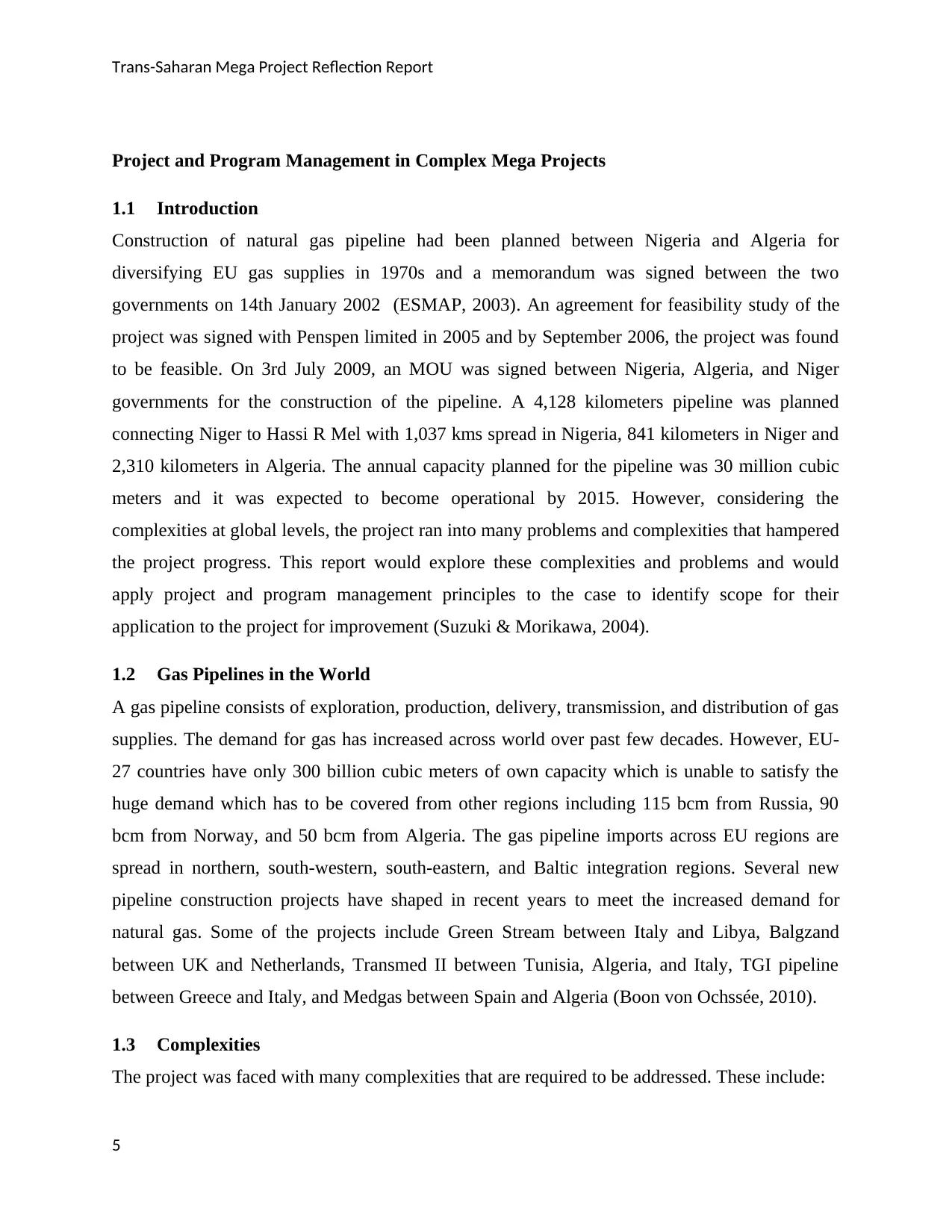
Trans-Saharan Mega Project Reflection Report
Project and Program Management in Complex Mega Projects
1.1 Introduction
Construction of natural gas pipeline had been planned between Nigeria and Algeria for
diversifying EU gas supplies in 1970s and a memorandum was signed between the two
governments on 14th January 2002 (ESMAP, 2003). An agreement for feasibility study of the
project was signed with Penspen limited in 2005 and by September 2006, the project was found
to be feasible. On 3rd July 2009, an MOU was signed between Nigeria, Algeria, and Niger
governments for the construction of the pipeline. A 4,128 kilometers pipeline was planned
connecting Niger to Hassi R Mel with 1,037 kms spread in Nigeria, 841 kilometers in Niger and
2,310 kilometers in Algeria. The annual capacity planned for the pipeline was 30 million cubic
meters and it was expected to become operational by 2015. However, considering the
complexities at global levels, the project ran into many problems and complexities that hampered
the project progress. This report would explore these complexities and problems and would
apply project and program management principles to the case to identify scope for their
application to the project for improvement (Suzuki & Morikawa, 2004).
1.2 Gas Pipelines in the World
A gas pipeline consists of exploration, production, delivery, transmission, and distribution of gas
supplies. The demand for gas has increased across world over past few decades. However, EU-
27 countries have only 300 billion cubic meters of own capacity which is unable to satisfy the
huge demand which has to be covered from other regions including 115 bcm from Russia, 90
bcm from Norway, and 50 bcm from Algeria. The gas pipeline imports across EU regions are
spread in northern, south-western, south-eastern, and Baltic integration regions. Several new
pipeline construction projects have shaped in recent years to meet the increased demand for
natural gas. Some of the projects include Green Stream between Italy and Libya, Balgzand
between UK and Netherlands, Transmed II between Tunisia, Algeria, and Italy, TGI pipeline
between Greece and Italy, and Medgas between Spain and Algeria (Boon von Ochssée, 2010).
1.3 Complexities
The project was faced with many complexities that are required to be addressed. These include:
5
Project and Program Management in Complex Mega Projects
1.1 Introduction
Construction of natural gas pipeline had been planned between Nigeria and Algeria for
diversifying EU gas supplies in 1970s and a memorandum was signed between the two
governments on 14th January 2002 (ESMAP, 2003). An agreement for feasibility study of the
project was signed with Penspen limited in 2005 and by September 2006, the project was found
to be feasible. On 3rd July 2009, an MOU was signed between Nigeria, Algeria, and Niger
governments for the construction of the pipeline. A 4,128 kilometers pipeline was planned
connecting Niger to Hassi R Mel with 1,037 kms spread in Nigeria, 841 kilometers in Niger and
2,310 kilometers in Algeria. The annual capacity planned for the pipeline was 30 million cubic
meters and it was expected to become operational by 2015. However, considering the
complexities at global levels, the project ran into many problems and complexities that hampered
the project progress. This report would explore these complexities and problems and would
apply project and program management principles to the case to identify scope for their
application to the project for improvement (Suzuki & Morikawa, 2004).
1.2 Gas Pipelines in the World
A gas pipeline consists of exploration, production, delivery, transmission, and distribution of gas
supplies. The demand for gas has increased across world over past few decades. However, EU-
27 countries have only 300 billion cubic meters of own capacity which is unable to satisfy the
huge demand which has to be covered from other regions including 115 bcm from Russia, 90
bcm from Norway, and 50 bcm from Algeria. The gas pipeline imports across EU regions are
spread in northern, south-western, south-eastern, and Baltic integration regions. Several new
pipeline construction projects have shaped in recent years to meet the increased demand for
natural gas. Some of the projects include Green Stream between Italy and Libya, Balgzand
between UK and Netherlands, Transmed II between Tunisia, Algeria, and Italy, TGI pipeline
between Greece and Italy, and Medgas between Spain and Algeria (Boon von Ochssée, 2010).
1.3 Complexities
The project was faced with many complexities that are required to be addressed. These include:
5
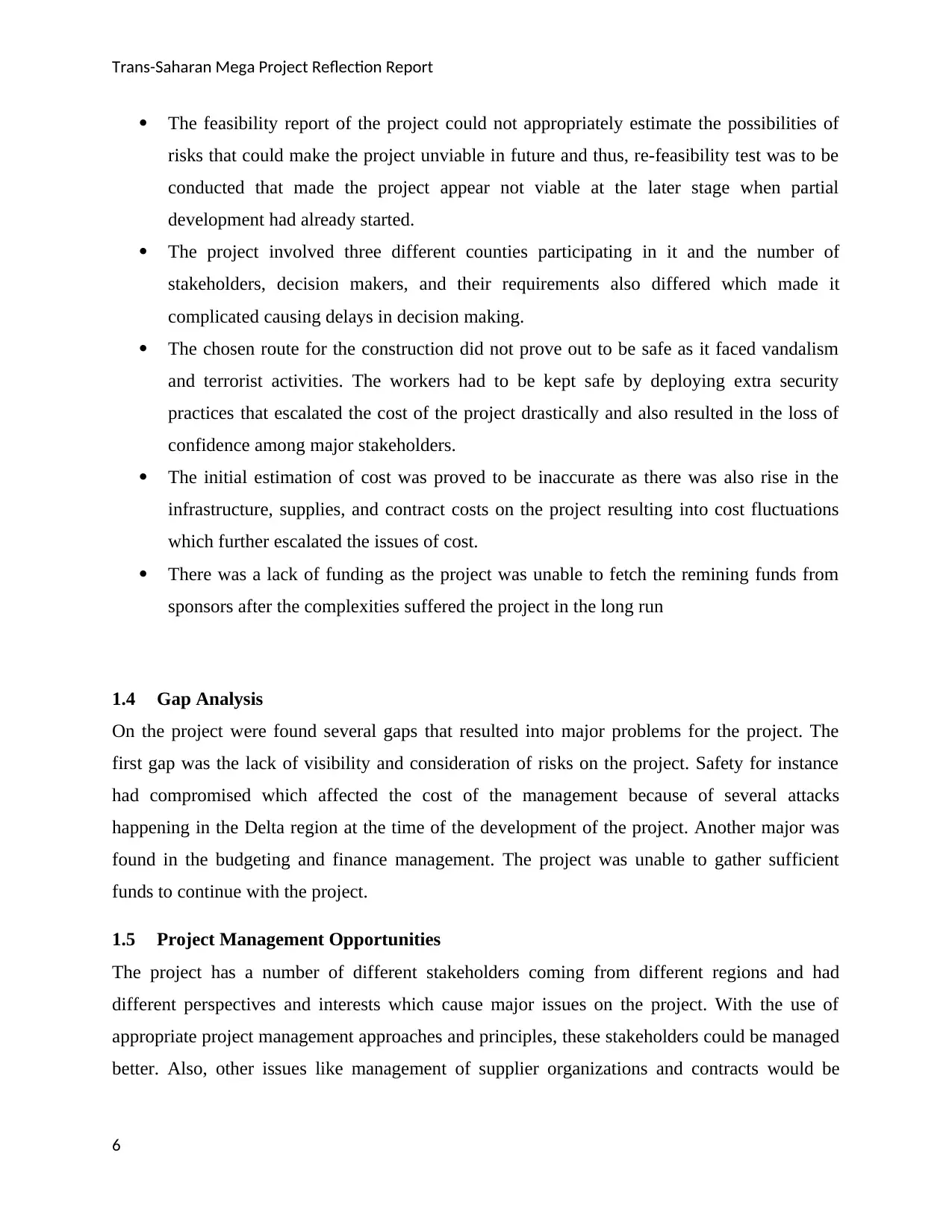
Trans-Saharan Mega Project Reflection Report
The feasibility report of the project could not appropriately estimate the possibilities of
risks that could make the project unviable in future and thus, re-feasibility test was to be
conducted that made the project appear not viable at the later stage when partial
development had already started.
The project involved three different counties participating in it and the number of
stakeholders, decision makers, and their requirements also differed which made it
complicated causing delays in decision making.
The chosen route for the construction did not prove out to be safe as it faced vandalism
and terrorist activities. The workers had to be kept safe by deploying extra security
practices that escalated the cost of the project drastically and also resulted in the loss of
confidence among major stakeholders.
The initial estimation of cost was proved to be inaccurate as there was also rise in the
infrastructure, supplies, and contract costs on the project resulting into cost fluctuations
which further escalated the issues of cost.
There was a lack of funding as the project was unable to fetch the remining funds from
sponsors after the complexities suffered the project in the long run
1.4 Gap Analysis
On the project were found several gaps that resulted into major problems for the project. The
first gap was the lack of visibility and consideration of risks on the project. Safety for instance
had compromised which affected the cost of the management because of several attacks
happening in the Delta region at the time of the development of the project. Another major was
found in the budgeting and finance management. The project was unable to gather sufficient
funds to continue with the project.
1.5 Project Management Opportunities
The project has a number of different stakeholders coming from different regions and had
different perspectives and interests which cause major issues on the project. With the use of
appropriate project management approaches and principles, these stakeholders could be managed
better. Also, other issues like management of supplier organizations and contracts would be
6
The feasibility report of the project could not appropriately estimate the possibilities of
risks that could make the project unviable in future and thus, re-feasibility test was to be
conducted that made the project appear not viable at the later stage when partial
development had already started.
The project involved three different counties participating in it and the number of
stakeholders, decision makers, and their requirements also differed which made it
complicated causing delays in decision making.
The chosen route for the construction did not prove out to be safe as it faced vandalism
and terrorist activities. The workers had to be kept safe by deploying extra security
practices that escalated the cost of the project drastically and also resulted in the loss of
confidence among major stakeholders.
The initial estimation of cost was proved to be inaccurate as there was also rise in the
infrastructure, supplies, and contract costs on the project resulting into cost fluctuations
which further escalated the issues of cost.
There was a lack of funding as the project was unable to fetch the remining funds from
sponsors after the complexities suffered the project in the long run
1.4 Gap Analysis
On the project were found several gaps that resulted into major problems for the project. The
first gap was the lack of visibility and consideration of risks on the project. Safety for instance
had compromised which affected the cost of the management because of several attacks
happening in the Delta region at the time of the development of the project. Another major was
found in the budgeting and finance management. The project was unable to gather sufficient
funds to continue with the project.
1.5 Project Management Opportunities
The project has a number of different stakeholders coming from different regions and had
different perspectives and interests which cause major issues on the project. With the use of
appropriate project management approaches and principles, these stakeholders could be managed
better. Also, other issues like management of supplier organizations and contracts would be
6
⊘ This is a preview!⊘
Do you want full access?
Subscribe today to unlock all pages.

Trusted by 1+ million students worldwide
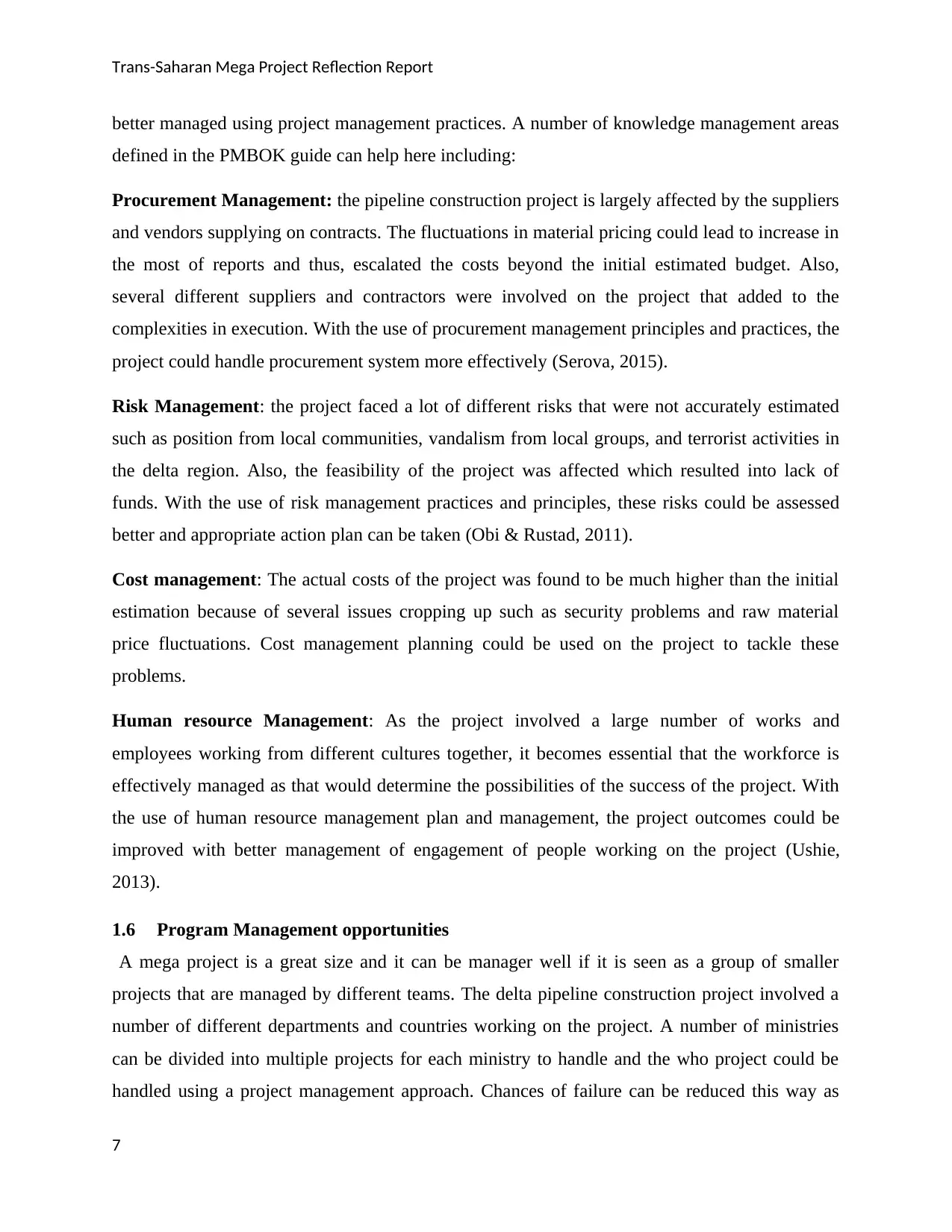
Trans-Saharan Mega Project Reflection Report
better managed using project management practices. A number of knowledge management areas
defined in the PMBOK guide can help here including:
Procurement Management: the pipeline construction project is largely affected by the suppliers
and vendors supplying on contracts. The fluctuations in material pricing could lead to increase in
the most of reports and thus, escalated the costs beyond the initial estimated budget. Also,
several different suppliers and contractors were involved on the project that added to the
complexities in execution. With the use of procurement management principles and practices, the
project could handle procurement system more effectively (Serova, 2015).
Risk Management: the project faced a lot of different risks that were not accurately estimated
such as position from local communities, vandalism from local groups, and terrorist activities in
the delta region. Also, the feasibility of the project was affected which resulted into lack of
funds. With the use of risk management practices and principles, these risks could be assessed
better and appropriate action plan can be taken (Obi & Rustad, 2011).
Cost management: The actual costs of the project was found to be much higher than the initial
estimation because of several issues cropping up such as security problems and raw material
price fluctuations. Cost management planning could be used on the project to tackle these
problems.
Human resource Management: As the project involved a large number of works and
employees working from different cultures together, it becomes essential that the workforce is
effectively managed as that would determine the possibilities of the success of the project. With
the use of human resource management plan and management, the project outcomes could be
improved with better management of engagement of people working on the project (Ushie,
2013).
1.6 Program Management opportunities
A mega project is a great size and it can be manager well if it is seen as a group of smaller
projects that are managed by different teams. The delta pipeline construction project involved a
number of different departments and countries working on the project. A number of ministries
can be divided into multiple projects for each ministry to handle and the who project could be
handled using a project management approach. Chances of failure can be reduced this way as
7
better managed using project management practices. A number of knowledge management areas
defined in the PMBOK guide can help here including:
Procurement Management: the pipeline construction project is largely affected by the suppliers
and vendors supplying on contracts. The fluctuations in material pricing could lead to increase in
the most of reports and thus, escalated the costs beyond the initial estimated budget. Also,
several different suppliers and contractors were involved on the project that added to the
complexities in execution. With the use of procurement management principles and practices, the
project could handle procurement system more effectively (Serova, 2015).
Risk Management: the project faced a lot of different risks that were not accurately estimated
such as position from local communities, vandalism from local groups, and terrorist activities in
the delta region. Also, the feasibility of the project was affected which resulted into lack of
funds. With the use of risk management practices and principles, these risks could be assessed
better and appropriate action plan can be taken (Obi & Rustad, 2011).
Cost management: The actual costs of the project was found to be much higher than the initial
estimation because of several issues cropping up such as security problems and raw material
price fluctuations. Cost management planning could be used on the project to tackle these
problems.
Human resource Management: As the project involved a large number of works and
employees working from different cultures together, it becomes essential that the workforce is
effectively managed as that would determine the possibilities of the success of the project. With
the use of human resource management plan and management, the project outcomes could be
improved with better management of engagement of people working on the project (Ushie,
2013).
1.6 Program Management opportunities
A mega project is a great size and it can be manager well if it is seen as a group of smaller
projects that are managed by different teams. The delta pipeline construction project involved a
number of different departments and countries working on the project. A number of ministries
can be divided into multiple projects for each ministry to handle and the who project could be
handled using a project management approach. Chances of failure can be reduced this way as
7
Paraphrase This Document
Need a fresh take? Get an instant paraphrase of this document with our AI Paraphraser
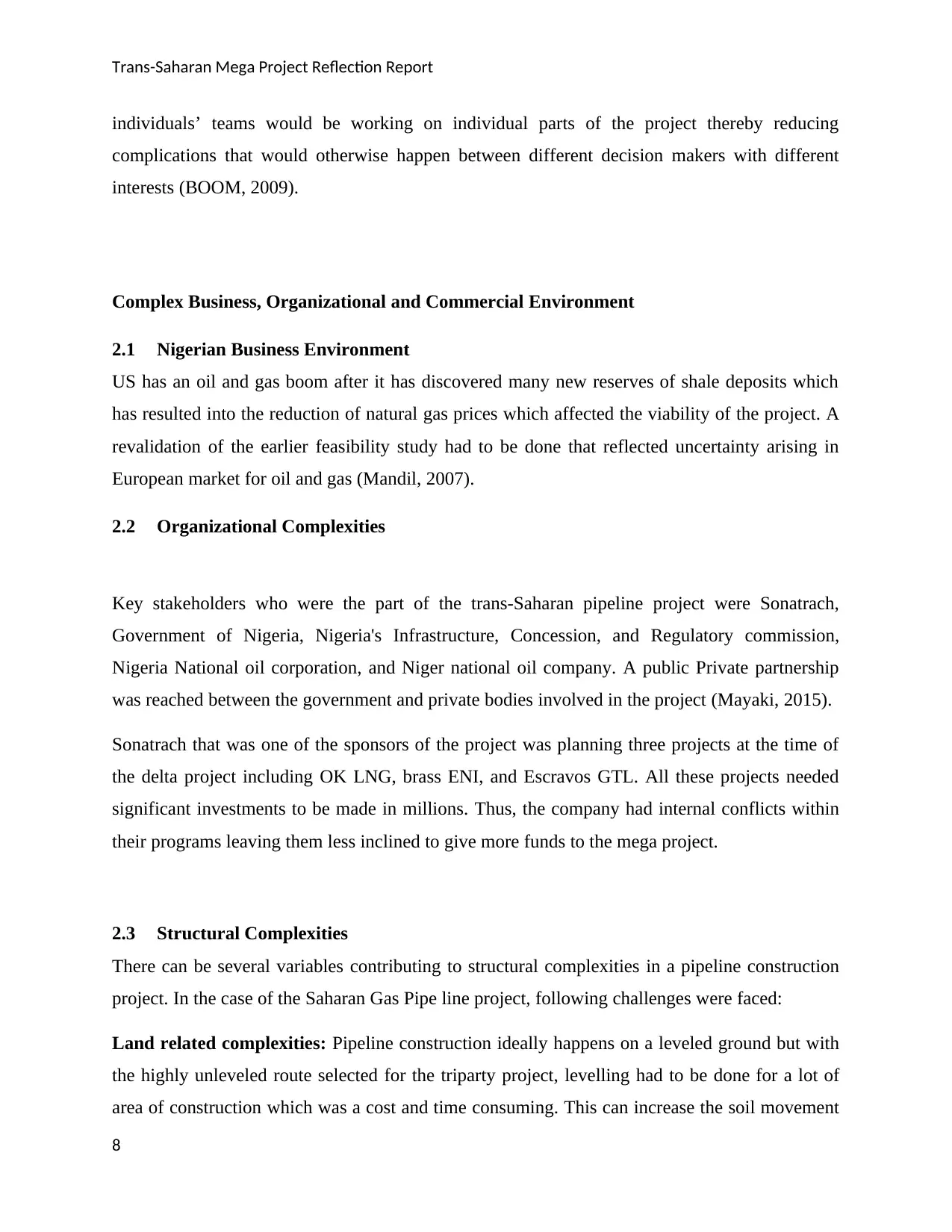
Trans-Saharan Mega Project Reflection Report
individuals’ teams would be working on individual parts of the project thereby reducing
complications that would otherwise happen between different decision makers with different
interests (BOOM, 2009).
Complex Business, Organizational and Commercial Environment
2.1 Nigerian Business Environment
US has an oil and gas boom after it has discovered many new reserves of shale deposits which
has resulted into the reduction of natural gas prices which affected the viability of the project. A
revalidation of the earlier feasibility study had to be done that reflected uncertainty arising in
European market for oil and gas (Mandil, 2007).
2.2 Organizational Complexities
Key stakeholders who were the part of the trans-Saharan pipeline project were Sonatrach,
Government of Nigeria, Nigeria's Infrastructure, Concession, and Regulatory commission,
Nigeria National oil corporation, and Niger national oil company. A public Private partnership
was reached between the government and private bodies involved in the project (Mayaki, 2015).
Sonatrach that was one of the sponsors of the project was planning three projects at the time of
the delta project including OK LNG, brass ENI, and Escravos GTL. All these projects needed
significant investments to be made in millions. Thus, the company had internal conflicts within
their programs leaving them less inclined to give more funds to the mega project.
2.3 Structural Complexities
There can be several variables contributing to structural complexities in a pipeline construction
project. In the case of the Saharan Gas Pipe line project, following challenges were faced:
Land related complexities: Pipeline construction ideally happens on a leveled ground but with
the highly unleveled route selected for the triparty project, levelling had to be done for a lot of
area of construction which was a cost and time consuming. This can increase the soil movement
8
individuals’ teams would be working on individual parts of the project thereby reducing
complications that would otherwise happen between different decision makers with different
interests (BOOM, 2009).
Complex Business, Organizational and Commercial Environment
2.1 Nigerian Business Environment
US has an oil and gas boom after it has discovered many new reserves of shale deposits which
has resulted into the reduction of natural gas prices which affected the viability of the project. A
revalidation of the earlier feasibility study had to be done that reflected uncertainty arising in
European market for oil and gas (Mandil, 2007).
2.2 Organizational Complexities
Key stakeholders who were the part of the trans-Saharan pipeline project were Sonatrach,
Government of Nigeria, Nigeria's Infrastructure, Concession, and Regulatory commission,
Nigeria National oil corporation, and Niger national oil company. A public Private partnership
was reached between the government and private bodies involved in the project (Mayaki, 2015).
Sonatrach that was one of the sponsors of the project was planning three projects at the time of
the delta project including OK LNG, brass ENI, and Escravos GTL. All these projects needed
significant investments to be made in millions. Thus, the company had internal conflicts within
their programs leaving them less inclined to give more funds to the mega project.
2.3 Structural Complexities
There can be several variables contributing to structural complexities in a pipeline construction
project. In the case of the Saharan Gas Pipe line project, following challenges were faced:
Land related complexities: Pipeline construction ideally happens on a leveled ground but with
the highly unleveled route selected for the triparty project, levelling had to be done for a lot of
area of construction which was a cost and time consuming. This can increase the soil movement
8
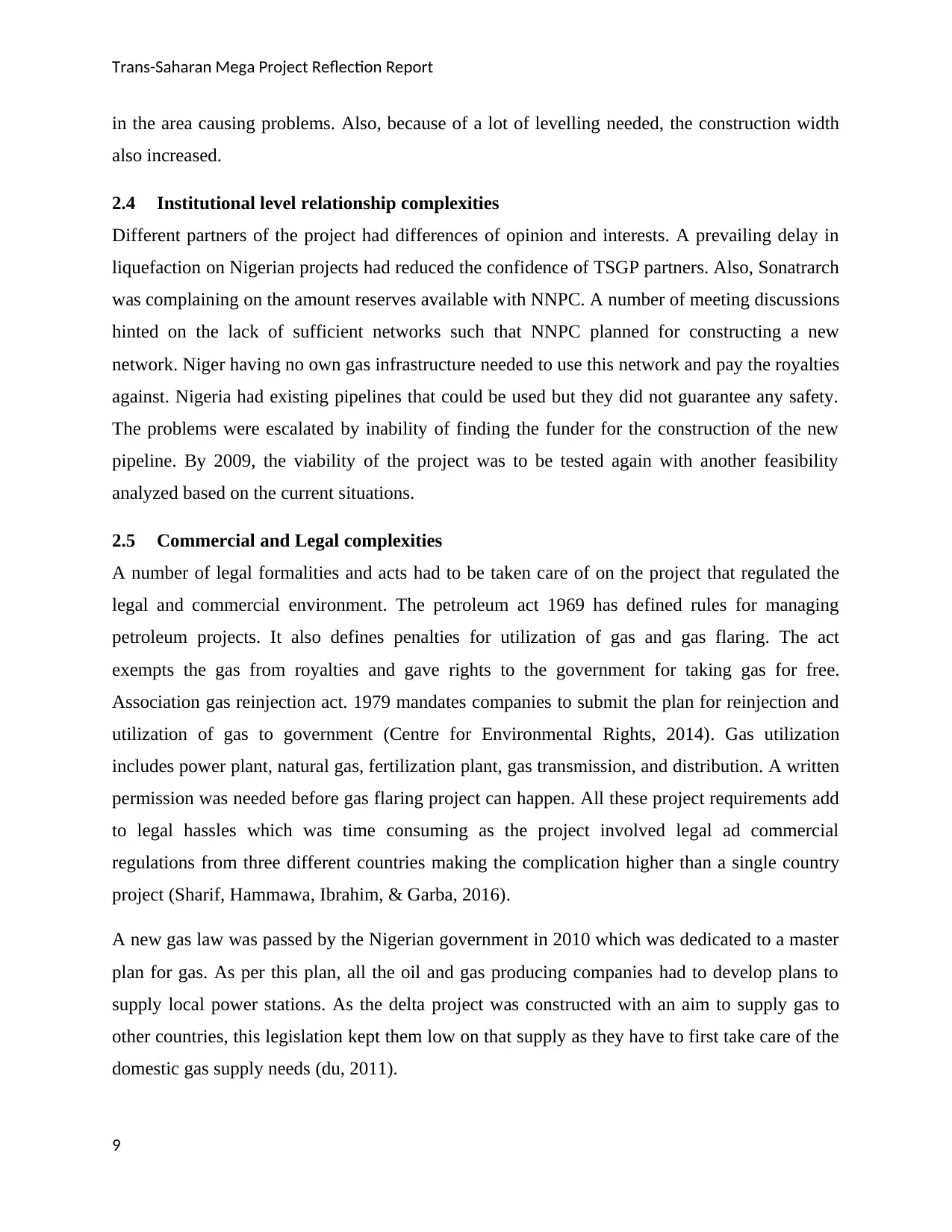
Trans-Saharan Mega Project Reflection Report
in the area causing problems. Also, because of a lot of levelling needed, the construction width
also increased.
2.4 Institutional level relationship complexities
Different partners of the project had differences of opinion and interests. A prevailing delay in
liquefaction on Nigerian projects had reduced the confidence of TSGP partners. Also, Sonatrarch
was complaining on the amount reserves available with NNPC. A number of meeting discussions
hinted on the lack of sufficient networks such that NNPC planned for constructing a new
network. Niger having no own gas infrastructure needed to use this network and pay the royalties
against. Nigeria had existing pipelines that could be used but they did not guarantee any safety.
The problems were escalated by inability of finding the funder for the construction of the new
pipeline. By 2009, the viability of the project was to be tested again with another feasibility
analyzed based on the current situations.
2.5 Commercial and Legal complexities
A number of legal formalities and acts had to be taken care of on the project that regulated the
legal and commercial environment. The petroleum act 1969 has defined rules for managing
petroleum projects. It also defines penalties for utilization of gas and gas flaring. The act
exempts the gas from royalties and gave rights to the government for taking gas for free.
Association gas reinjection act. 1979 mandates companies to submit the plan for reinjection and
utilization of gas to government (Centre for Environmental Rights, 2014). Gas utilization
includes power plant, natural gas, fertilization plant, gas transmission, and distribution. A written
permission was needed before gas flaring project can happen. All these project requirements add
to legal hassles which was time consuming as the project involved legal ad commercial
regulations from three different countries making the complication higher than a single country
project (Sharif, Hammawa, Ibrahim, & Garba, 2016).
A new gas law was passed by the Nigerian government in 2010 which was dedicated to a master
plan for gas. As per this plan, all the oil and gas producing companies had to develop plans to
supply local power stations. As the delta project was constructed with an aim to supply gas to
other countries, this legislation kept them low on that supply as they have to first take care of the
domestic gas supply needs (du, 2011).
9
in the area causing problems. Also, because of a lot of levelling needed, the construction width
also increased.
2.4 Institutional level relationship complexities
Different partners of the project had differences of opinion and interests. A prevailing delay in
liquefaction on Nigerian projects had reduced the confidence of TSGP partners. Also, Sonatrarch
was complaining on the amount reserves available with NNPC. A number of meeting discussions
hinted on the lack of sufficient networks such that NNPC planned for constructing a new
network. Niger having no own gas infrastructure needed to use this network and pay the royalties
against. Nigeria had existing pipelines that could be used but they did not guarantee any safety.
The problems were escalated by inability of finding the funder for the construction of the new
pipeline. By 2009, the viability of the project was to be tested again with another feasibility
analyzed based on the current situations.
2.5 Commercial and Legal complexities
A number of legal formalities and acts had to be taken care of on the project that regulated the
legal and commercial environment. The petroleum act 1969 has defined rules for managing
petroleum projects. It also defines penalties for utilization of gas and gas flaring. The act
exempts the gas from royalties and gave rights to the government for taking gas for free.
Association gas reinjection act. 1979 mandates companies to submit the plan for reinjection and
utilization of gas to government (Centre for Environmental Rights, 2014). Gas utilization
includes power plant, natural gas, fertilization plant, gas transmission, and distribution. A written
permission was needed before gas flaring project can happen. All these project requirements add
to legal hassles which was time consuming as the project involved legal ad commercial
regulations from three different countries making the complication higher than a single country
project (Sharif, Hammawa, Ibrahim, & Garba, 2016).
A new gas law was passed by the Nigerian government in 2010 which was dedicated to a master
plan for gas. As per this plan, all the oil and gas producing companies had to develop plans to
supply local power stations. As the delta project was constructed with an aim to supply gas to
other countries, this legislation kept them low on that supply as they have to first take care of the
domestic gas supply needs (du, 2011).
9
⊘ This is a preview!⊘
Do you want full access?
Subscribe today to unlock all pages.

Trusted by 1+ million students worldwide
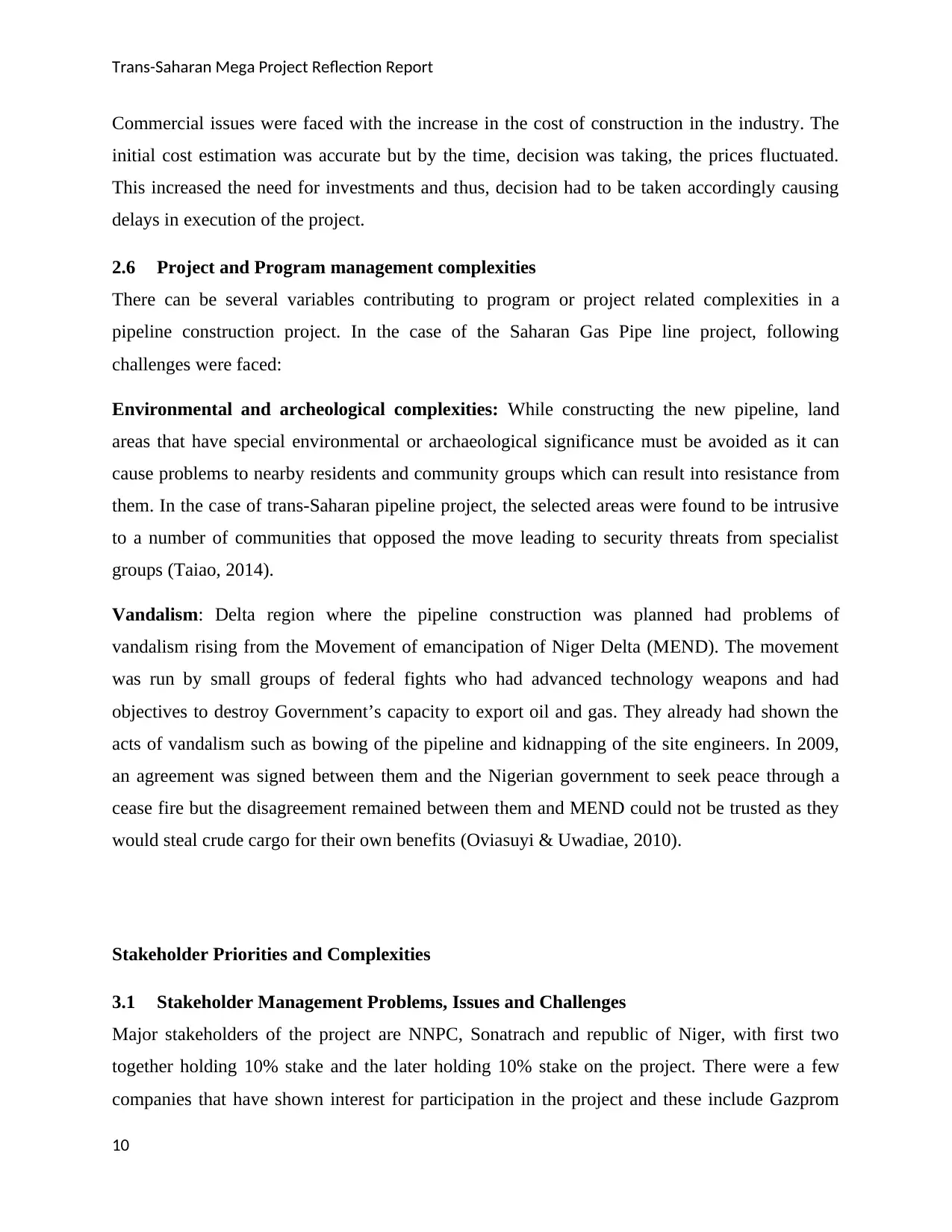
Trans-Saharan Mega Project Reflection Report
Commercial issues were faced with the increase in the cost of construction in the industry. The
initial cost estimation was accurate but by the time, decision was taking, the prices fluctuated.
This increased the need for investments and thus, decision had to be taken accordingly causing
delays in execution of the project.
2.6 Project and Program management complexities
There can be several variables contributing to program or project related complexities in a
pipeline construction project. In the case of the Saharan Gas Pipe line project, following
challenges were faced:
Environmental and archeological complexities: While constructing the new pipeline, land
areas that have special environmental or archaeological significance must be avoided as it can
cause problems to nearby residents and community groups which can result into resistance from
them. In the case of trans-Saharan pipeline project, the selected areas were found to be intrusive
to a number of communities that opposed the move leading to security threats from specialist
groups (Taiao, 2014).
Vandalism: Delta region where the pipeline construction was planned had problems of
vandalism rising from the Movement of emancipation of Niger Delta (MEND). The movement
was run by small groups of federal fights who had advanced technology weapons and had
objectives to destroy Government’s capacity to export oil and gas. They already had shown the
acts of vandalism such as bowing of the pipeline and kidnapping of the site engineers. In 2009,
an agreement was signed between them and the Nigerian government to seek peace through a
cease fire but the disagreement remained between them and MEND could not be trusted as they
would steal crude cargo for their own benefits (Oviasuyi & Uwadiae, 2010).
Stakeholder Priorities and Complexities
3.1 Stakeholder Management Problems, Issues and Challenges
Major stakeholders of the project are NNPC, Sonatrach and republic of Niger, with first two
together holding 10% stake and the later holding 10% stake on the project. There were a few
companies that have shown interest for participation in the project and these include Gazprom
10
Commercial issues were faced with the increase in the cost of construction in the industry. The
initial cost estimation was accurate but by the time, decision was taking, the prices fluctuated.
This increased the need for investments and thus, decision had to be taken accordingly causing
delays in execution of the project.
2.6 Project and Program management complexities
There can be several variables contributing to program or project related complexities in a
pipeline construction project. In the case of the Saharan Gas Pipe line project, following
challenges were faced:
Environmental and archeological complexities: While constructing the new pipeline, land
areas that have special environmental or archaeological significance must be avoided as it can
cause problems to nearby residents and community groups which can result into resistance from
them. In the case of trans-Saharan pipeline project, the selected areas were found to be intrusive
to a number of communities that opposed the move leading to security threats from specialist
groups (Taiao, 2014).
Vandalism: Delta region where the pipeline construction was planned had problems of
vandalism rising from the Movement of emancipation of Niger Delta (MEND). The movement
was run by small groups of federal fights who had advanced technology weapons and had
objectives to destroy Government’s capacity to export oil and gas. They already had shown the
acts of vandalism such as bowing of the pipeline and kidnapping of the site engineers. In 2009,
an agreement was signed between them and the Nigerian government to seek peace through a
cease fire but the disagreement remained between them and MEND could not be trusted as they
would steal crude cargo for their own benefits (Oviasuyi & Uwadiae, 2010).
Stakeholder Priorities and Complexities
3.1 Stakeholder Management Problems, Issues and Challenges
Major stakeholders of the project are NNPC, Sonatrach and republic of Niger, with first two
together holding 10% stake and the later holding 10% stake on the project. There were a few
companies that have shown interest for participation in the project and these include Gazprom
10
Paraphrase This Document
Need a fresh take? Get an instant paraphrase of this document with our AI Paraphraser
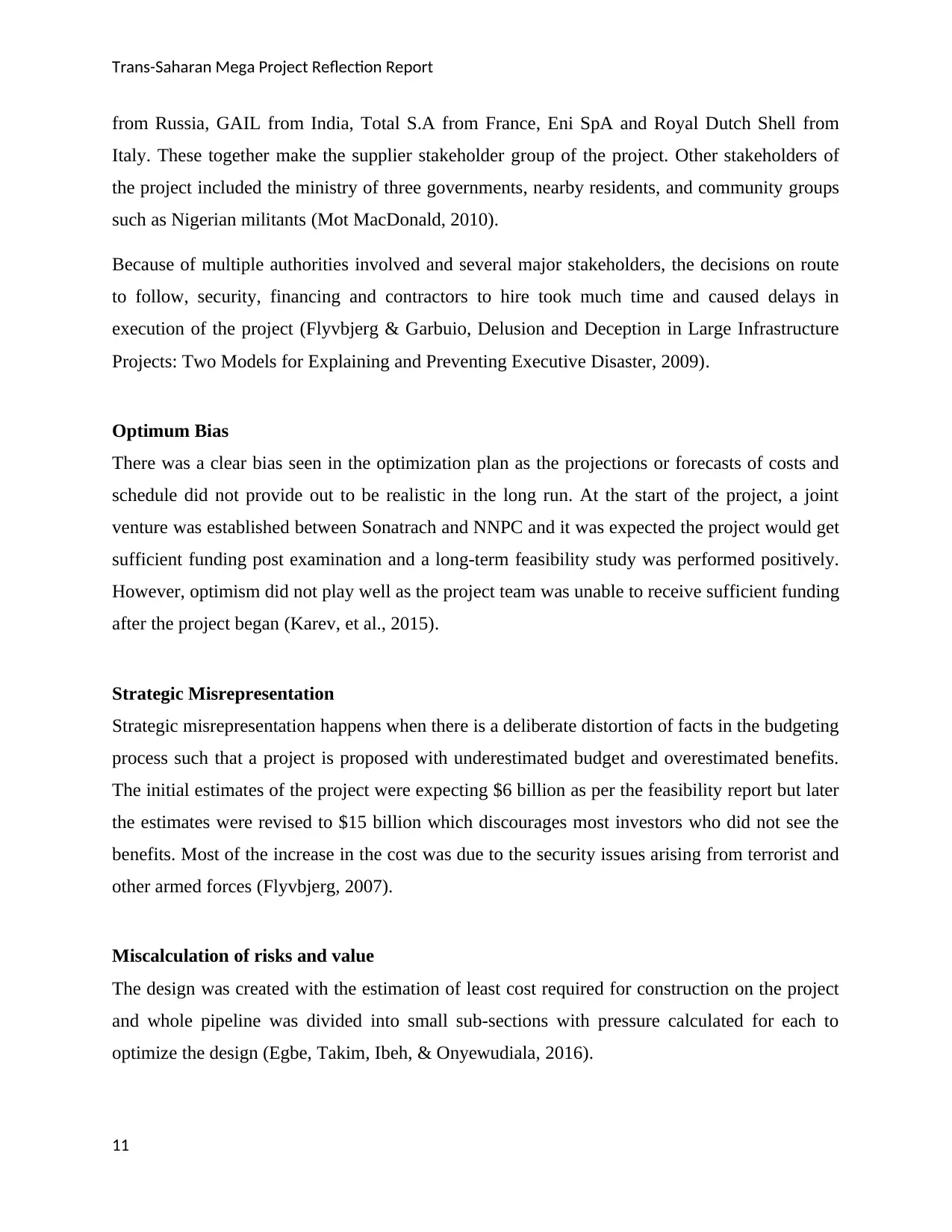
Trans-Saharan Mega Project Reflection Report
from Russia, GAIL from India, Total S.A from France, Eni SpA and Royal Dutch Shell from
Italy. These together make the supplier stakeholder group of the project. Other stakeholders of
the project included the ministry of three governments, nearby residents, and community groups
such as Nigerian militants (Mot MacDonald, 2010).
Because of multiple authorities involved and several major stakeholders, the decisions on route
to follow, security, financing and contractors to hire took much time and caused delays in
execution of the project (Flyvbjerg & Garbuio, Delusion and Deception in Large Infrastructure
Projects: Two Models for Explaining and Preventing Executive Disaster, 2009).
Optimum Bias
There was a clear bias seen in the optimization plan as the projections or forecasts of costs and
schedule did not provide out to be realistic in the long run. At the start of the project, a joint
venture was established between Sonatrach and NNPC and it was expected the project would get
sufficient funding post examination and a long-term feasibility study was performed positively.
However, optimism did not play well as the project team was unable to receive sufficient funding
after the project began (Karev, et al., 2015).
Strategic Misrepresentation
Strategic misrepresentation happens when there is a deliberate distortion of facts in the budgeting
process such that a project is proposed with underestimated budget and overestimated benefits.
The initial estimates of the project were expecting $6 billion as per the feasibility report but later
the estimates were revised to $15 billion which discourages most investors who did not see the
benefits. Most of the increase in the cost was due to the security issues arising from terrorist and
other armed forces (Flyvbjerg, 2007).
Miscalculation of risks and value
The design was created with the estimation of least cost required for construction on the project
and whole pipeline was divided into small sub-sections with pressure calculated for each to
optimize the design (Egbe, Takim, Ibeh, & Onyewudiala, 2016).
11
from Russia, GAIL from India, Total S.A from France, Eni SpA and Royal Dutch Shell from
Italy. These together make the supplier stakeholder group of the project. Other stakeholders of
the project included the ministry of three governments, nearby residents, and community groups
such as Nigerian militants (Mot MacDonald, 2010).
Because of multiple authorities involved and several major stakeholders, the decisions on route
to follow, security, financing and contractors to hire took much time and caused delays in
execution of the project (Flyvbjerg & Garbuio, Delusion and Deception in Large Infrastructure
Projects: Two Models for Explaining and Preventing Executive Disaster, 2009).
Optimum Bias
There was a clear bias seen in the optimization plan as the projections or forecasts of costs and
schedule did not provide out to be realistic in the long run. At the start of the project, a joint
venture was established between Sonatrach and NNPC and it was expected the project would get
sufficient funding post examination and a long-term feasibility study was performed positively.
However, optimism did not play well as the project team was unable to receive sufficient funding
after the project began (Karev, et al., 2015).
Strategic Misrepresentation
Strategic misrepresentation happens when there is a deliberate distortion of facts in the budgeting
process such that a project is proposed with underestimated budget and overestimated benefits.
The initial estimates of the project were expecting $6 billion as per the feasibility report but later
the estimates were revised to $15 billion which discourages most investors who did not see the
benefits. Most of the increase in the cost was due to the security issues arising from terrorist and
other armed forces (Flyvbjerg, 2007).
Miscalculation of risks and value
The design was created with the estimation of least cost required for construction on the project
and whole pipeline was divided into small sub-sections with pressure calculated for each to
optimize the design (Egbe, Takim, Ibeh, & Onyewudiala, 2016).
11
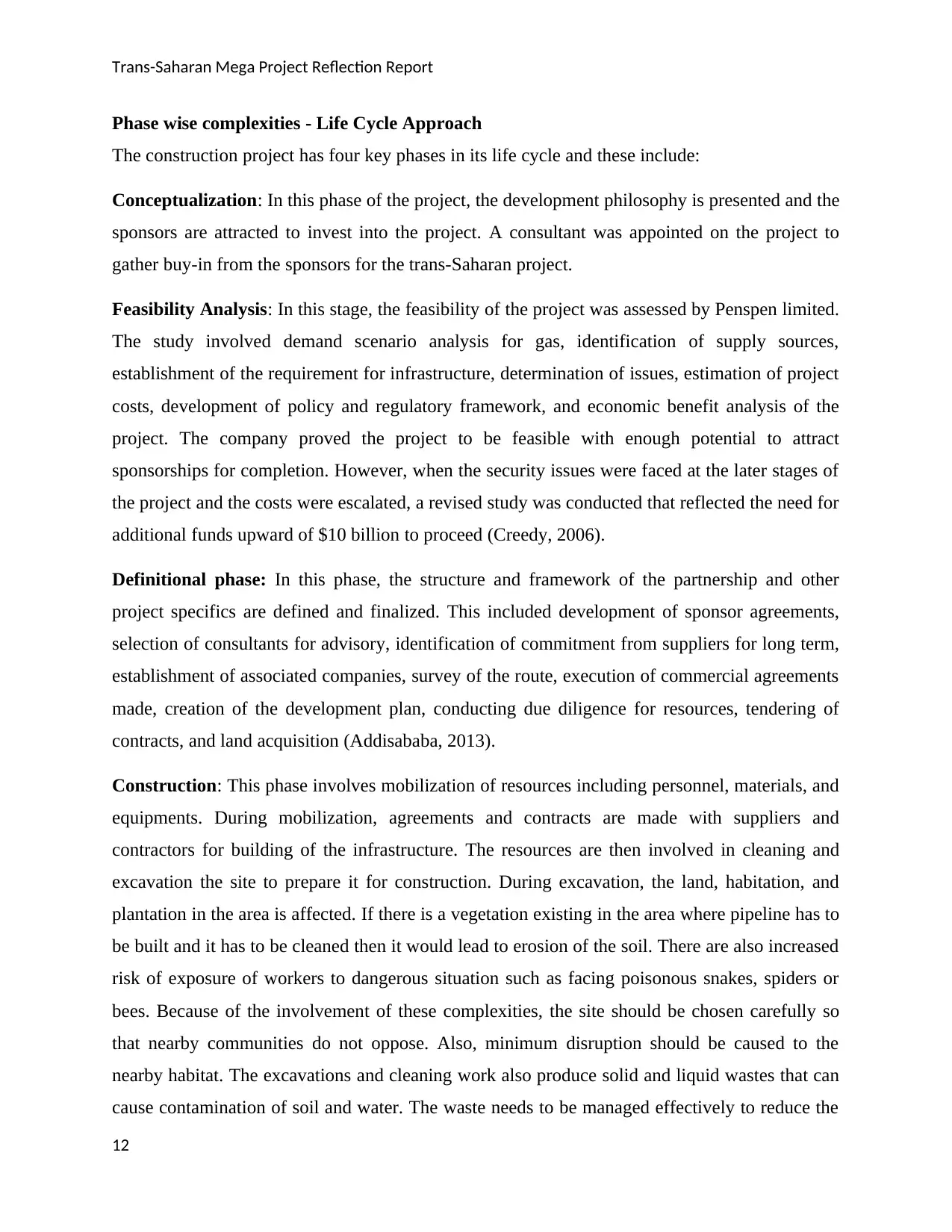
Trans-Saharan Mega Project Reflection Report
Phase wise complexities - Life Cycle Approach
The construction project has four key phases in its life cycle and these include:
Conceptualization: In this phase of the project, the development philosophy is presented and the
sponsors are attracted to invest into the project. A consultant was appointed on the project to
gather buy-in from the sponsors for the trans-Saharan project.
Feasibility Analysis: In this stage, the feasibility of the project was assessed by Penspen limited.
The study involved demand scenario analysis for gas, identification of supply sources,
establishment of the requirement for infrastructure, determination of issues, estimation of project
costs, development of policy and regulatory framework, and economic benefit analysis of the
project. The company proved the project to be feasible with enough potential to attract
sponsorships for completion. However, when the security issues were faced at the later stages of
the project and the costs were escalated, a revised study was conducted that reflected the need for
additional funds upward of $10 billion to proceed (Creedy, 2006).
Definitional phase: In this phase, the structure and framework of the partnership and other
project specifics are defined and finalized. This included development of sponsor agreements,
selection of consultants for advisory, identification of commitment from suppliers for long term,
establishment of associated companies, survey of the route, execution of commercial agreements
made, creation of the development plan, conducting due diligence for resources, tendering of
contracts, and land acquisition (Addisababa, 2013).
Construction: This phase involves mobilization of resources including personnel, materials, and
equipments. During mobilization, agreements and contracts are made with suppliers and
contractors for building of the infrastructure. The resources are then involved in cleaning and
excavation the site to prepare it for construction. During excavation, the land, habitation, and
plantation in the area is affected. If there is a vegetation existing in the area where pipeline has to
be built and it has to be cleaned then it would lead to erosion of the soil. There are also increased
risk of exposure of workers to dangerous situation such as facing poisonous snakes, spiders or
bees. Because of the involvement of these complexities, the site should be chosen carefully so
that nearby communities do not oppose. Also, minimum disruption should be caused to the
nearby habitat. The excavations and cleaning work also produce solid and liquid wastes that can
cause contamination of soil and water. The waste needs to be managed effectively to reduce the
12
Phase wise complexities - Life Cycle Approach
The construction project has four key phases in its life cycle and these include:
Conceptualization: In this phase of the project, the development philosophy is presented and the
sponsors are attracted to invest into the project. A consultant was appointed on the project to
gather buy-in from the sponsors for the trans-Saharan project.
Feasibility Analysis: In this stage, the feasibility of the project was assessed by Penspen limited.
The study involved demand scenario analysis for gas, identification of supply sources,
establishment of the requirement for infrastructure, determination of issues, estimation of project
costs, development of policy and regulatory framework, and economic benefit analysis of the
project. The company proved the project to be feasible with enough potential to attract
sponsorships for completion. However, when the security issues were faced at the later stages of
the project and the costs were escalated, a revised study was conducted that reflected the need for
additional funds upward of $10 billion to proceed (Creedy, 2006).
Definitional phase: In this phase, the structure and framework of the partnership and other
project specifics are defined and finalized. This included development of sponsor agreements,
selection of consultants for advisory, identification of commitment from suppliers for long term,
establishment of associated companies, survey of the route, execution of commercial agreements
made, creation of the development plan, conducting due diligence for resources, tendering of
contracts, and land acquisition (Addisababa, 2013).
Construction: This phase involves mobilization of resources including personnel, materials, and
equipments. During mobilization, agreements and contracts are made with suppliers and
contractors for building of the infrastructure. The resources are then involved in cleaning and
excavation the site to prepare it for construction. During excavation, the land, habitation, and
plantation in the area is affected. If there is a vegetation existing in the area where pipeline has to
be built and it has to be cleaned then it would lead to erosion of the soil. There are also increased
risk of exposure of workers to dangerous situation such as facing poisonous snakes, spiders or
bees. Because of the involvement of these complexities, the site should be chosen carefully so
that nearby communities do not oppose. Also, minimum disruption should be caused to the
nearby habitat. The excavations and cleaning work also produce solid and liquid wastes that can
cause contamination of soil and water. The waste needs to be managed effectively to reduce the
12
⊘ This is a preview!⊘
Do you want full access?
Subscribe today to unlock all pages.

Trusted by 1+ million students worldwide
1 out of 20
Related Documents
Your All-in-One AI-Powered Toolkit for Academic Success.
+13062052269
info@desklib.com
Available 24*7 on WhatsApp / Email
![[object Object]](/_next/static/media/star-bottom.7253800d.svg)
Unlock your academic potential
Copyright © 2020–2025 A2Z Services. All Rights Reserved. Developed and managed by ZUCOL.





